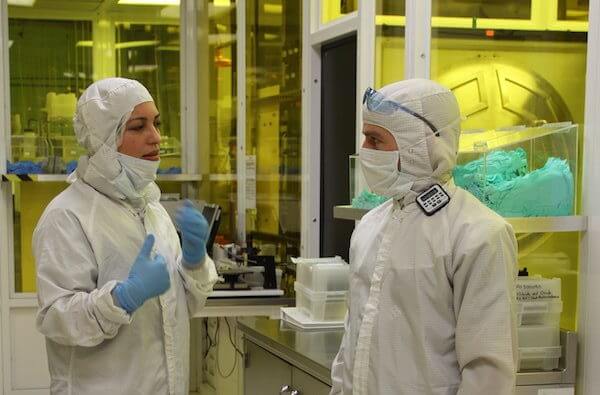 The number is sobering: according to the U.S. Bureau of Labor of Statistics, 16.9% of chemical engineers and 12.3% of electrical/electronics engineers in the US are women. For racial diversity, the situation is even worse. These grave statistics came to light during a recent panel discussion during SEMICON West, in its Workforce Pavilion. Here, Jessica Gomez, co-founder and CEO of Rogue Valley Microelectronics, co-hosted a session on data of diversity along with Ed Zabasajja, director, the office of data analytics and retention at Intel. “Based on the data, neither Ed nor I should be here!” Gomez declared.
The number is sobering: according to the U.S. Bureau of Labor of Statistics, 16.9% of chemical engineers and 12.3% of electrical/electronics engineers in the US are women. For racial diversity, the situation is even worse. These grave statistics came to light during a recent panel discussion during SEMICON West, in its Workforce Pavilion. Here, Jessica Gomez, co-founder and CEO of Rogue Valley Microelectronics, co-hosted a session on data of diversity along with Ed Zabasajja, director, the office of data analytics and retention at Intel. “Based on the data, neither Ed nor I should be here!” Gomez declared.
Despite the fact that Gomez is at the helm of a successful pure-play MEMS foundry, located in the “Silicon Forest” of Medford, Oregon, she can’t even include herself as part of that 16.9%. Because even though she can run wafers alongside the best of them, she’s not an engineer. So how did she get where she is, with the deck stacked against her as both a woman and a Latina? Through grit, determination, a little bit of luck, and a whole lot of take-charge attitude, Gomez managed to, as she puts it, “short-circuit the whole process.”
“I basically crowned myself,” she admitted – and I appreciated the “queen” reference. “I figured if I’m in charge, I can build the environment that I want to work in.” She and her husband, Patrick Kayatta, VP, co-founder and CTO, (and who IS, by the way, an engineer) built Rogue Valley Microelectronics together, creating policies that are more sensitive to parenting. As an engineering team, they have adapted the workplace to suit them and their employees.
A self-starter
If she’s not a formally trained engineer, where did Gomez develop her wafer-processing skills? On the job, she said. Gomez’ semiconductor story began in 1998 when she was juggling a full-time job and part-time community college where she was studying to become a software engineer. Her job was at Standard Microsystems in Hauppauge, NY, where she worked in a four-inch fab manufacturing ink-jet chips. She baked photoresist-coated wafers. “It was the most boring job. I didn’t think I’d make it through the first week,” she said. “But I loved the people. Everyone was so helpful. If you’re curious, they will help you learn.”
By and by, Gomez taught herself the manufacturing software and helped with its implantation on the manufacturing floor. That’s where she first met Kayatta, and they became friends. Eventually, Standard Microsystems was acquired. Both of them were recruited to Integrated Micromachines, an all-optical switch company based in Los Angeles, CA. Gomez was in charge of the company’s Manufacturing Execution Software implementation and got her first taste of fab management and sales. After the September 11, 2001 attacks, the company began to collapse.
 From the ashes
From the ashes
With a building and fully equipped MEMS fab available, Gomez and Kayatta along with a few colleagues from the company decided to start a foundry services business unit, which was moderately successful, “but not enough to carry the weight of the doctorate-level engineers,” said Gomez. When the company finally shut its doors, Gomez and Kayatta acquired part of the cleanroom and moved it up to Oregon where they developed the original business model for Rogue Valley Microelectronics, focused on providing thin film deposition services. That was 2004.
“We sold the house, leveraged bank loans, and did everything ourselves, from fitting pipe to fixing the vacuum pumps,” she said. In the beginning, Kayatta was CEO, but it turned out his best work was done on the engineering side, and she was more suited to running the business, so they switched.
Gomez and Kayatta started out with just a hand full of tools, Including a Thermal oxidation/LPCVD Nitride Furnace stack and wet clean bench purchased from Wafab. They received their first purchase order from Virginia Semiconductor for Thermal Oxidation on a batch of non-standard wafers, for which they received $800. They slowly reinvested in the company, expanding into a fully functional MEMS fab, joining Silex Microsystems, IMT, and Tronics (not part of TDK InvenSense), as the only US-based MEMS foundries.
“It was two years before we hired our first employee. We worked 16-18 hours day, every day,” she said. Now, 15 years later, the company is growing, and there are 25 full-time employees. But Gomez can still recall the excitement of the first day they turned on the furnace and did the first test run.
Along the way, Gomez and Kayatta added two daughters to the team. Now seven and three, the girls have been going to work with her since they were born.
Beyond success
Gomez isn’t only an activist for increasing diversity in the semiconductor industry. She’s also passionate about her community, education, and family matters. So much so that she’s now running for the Oregon State Senate. Where she has launched a campaign to represent her district in Oregon as a state senator.
Gomez is clearly proud of what she has accomplished, not only as a woman or minority in the semiconductor industry but as a person. She and Kayatta are raising their daughters to understand the value of hard work and determination. The core values they built Rogue Valley on tenacity, teamwork, humility, quality, and integrity, hold true today.
Calling all SemiSisters!
 For those of you not familiar with the SemiSisters, we are all the women who work in the semiconductor industry. We may be engineers, scientists, technologists, market analysts, executives, marketing & PR professionals and journalists. We factor in the X (chromosome, that is).
For those of you not familiar with the SemiSisters, we are all the women who work in the semiconductor industry. We may be engineers, scientists, technologists, market analysts, executives, marketing & PR professionals and journalists. We factor in the X (chromosome, that is).
SemiSisters started not long after I launched 3D InCites as a group of women who found each other, amidst a sea of men, at semiconductor industry conferences and networking events. We became an informal group with a LinkedIn page and a Twitter handle, and our activities have focused mostly on taking and posting group photos whenever we are together. But that’s about to change.
It’s time we grow our numbers. How can we encourage young women to forge their career path in the semiconductor industry? By sharing our own success stories! (You can find my own story along with tips from women in the trenches here.)
Over the next few months, we’ll be rolling out the SemiSister Project on 3D InCites in partnership with KIterocket. We’re kicking off the project with this blog series highlighting successful women who have made a significant impact on the semiconductor and related industries. Our hope is to inspire young women that they too can have a successful career in this exciting high-tech world.
We’ve already started a list of women we deem worthy of inclusion in this series, and we’re hoping you’ll add to it. Their stories will be shared over the next few months. Email me to learn more about how you and your company can become involved in this project. ~ FvT



















